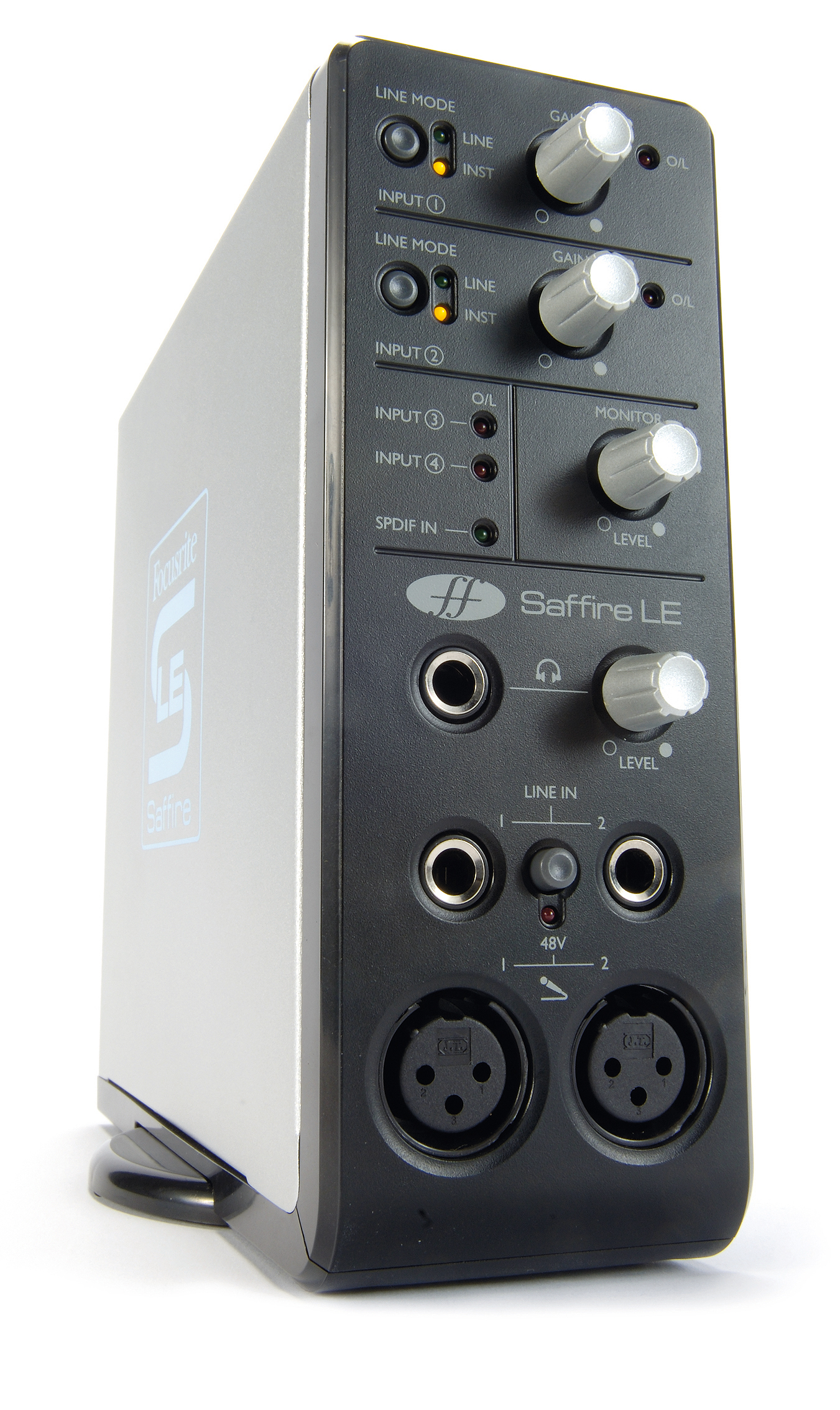MusicRadar Verdict
There´s no onboard DSP, but the Saffire LE is a fine and functional audio interface that will appeal to laptop musicians in particular.
Pros
- +
Sounds superb. Flexible zero-latency monitoring. Native plug-in bundle. Great build quality.
Cons
- -
Primitive panel metering. No bundled ‘traditional’ recording software. Software control panel is rather confusing.
MusicRadar's got your back


Physically, the Saffire LE is very similar to its big brother, the Saffire audio interface. Offering impressive build quality and the same convenient form factor, it's ideal for portable use.
This version lacks the onboard DSP processing features, has fewer analogue outputs and a lower maximum sampling rate (96kHz rather than 192kHz), but it does offer two more analogue inputs and ships with the same bundle of native Focusrite plug-ins.
The front panel sports two balanced XLR microphone inputs, two balanced line/instrument inputs on 1/4" jacks, one headphone output and basic gain and metering controls.
Focusrite hasn't opted for the combined XLR/jack inputs that you'll find on many interfaces - a slightly strange decision when you consider that only one of the sets of front panel inputs can be used at any one time.
The metering facilities on the front panel are extremely basic, comprising just two overload LEDs. Although more comprehensive metering options are available in the control panel software application, there are going to be occasions when better front panel metering would come in handy.
The rear panel hosts two more inputs and six outputs, all on balanced 1/4" jack connectors. The analogue outputs are helpfully dual-labelled with surround sound designations (more on this later), while a pair of coaxial S/PDIF connectors provides digital audio I/O.
The unit can be powered via a DC input on the rear panel, but most of the time, the Saffire LE will get its juice from the FireWire bus (providing a 6-pin cable is used to connect it to the computer). Two FireWire ports are provided so that other devices can be daisy-chained on the same FireWire port, but this is not recommended.
Want all the hottest music and gear news, reviews, deals, features and more, direct to your inbox? Sign up here.
A pair of MIDI connectors rounds off the external connectivity.
Installation
As with most FireWire audio interfaces, installation is a fairly straightforward affair. Using Windows, the Focusrite-supplied drivers must be installed first. Although the standard CoreAudio drivers that ship with OS X work fine, Mac users still need to install the control panel software (SaffireControl LE) to make full use of the hardware.
The control panel is nice enough to look at, but not exactly intuitive in use. Fortunately, everything becomes clear after you've read the supplied PDF manual.
Saffire LE sounds great and more than lives up to expectations. It's also worth noting that the audio specifications are identical for Saffire and Saffire LE - Focusrite haven't compromised the audio circuitry in the more affordable model.
As we've already mentioned, Saffire LE offers support for full AC3 and DTS surround sound, which is useful if you intend mix in surround or want the interface to be used as part of a home theatre setup.
The latency performance is as good as that of any other comparable FireWire audio interface we've used, with settings of around 5-8ms giving the best balance between low latency operation and bearable system load.
As the Saffire LE contains a flexible onboard mixer, it's capable of providing zero-latency monitoring during recording sessions. This feature would be more useful if combined with onboard audio effects (as it is on the full Saffire), but an external effects box could be used to provide similar functionality.
And thanks to the flexibility of the onboard mixer, most people won't need an additional hardware mixer, unless they have particularly complex monitoring or effects requirements.
Output issues
When we reviewed the original Saffire, we were concerned about the excessive signal levels that were present at the device's output. With the Saffire LE, this problem can be partially solved by switching on the DIM for outputs one and two in the centre of the control panel. Enabling this option effectively cuts the output level by 12dB.
But the question remains - why did Focusrite design the Saffire series in this way in the first place?
The Saffire LE might not have any groundbreaking new features to shout about, but it's still an excellent choice for anyone who wants a flexible and well-spec'd audio interface. The price is just about right and, crucially, it sounds fantastic.
MusicRadar is the number 1 website for music makers of all kinds, be they guitarists, drummers, keyboard players, djs or producers...
GEAR: We help musicians find the best gear with top-ranking gear round-ups and high- quality, authoritative reviews by a wide team of highly experienced experts.
TIPS: We also provide tuition, from bite-sized tips to advanced work-outs and guidance from recognised musicians and stars.
STARS: We talk to musicians and stars about their creative processes, and the nuts and bolts of their gear and technique. We give fans an insight into the actual craft of music making that no other music website can.
